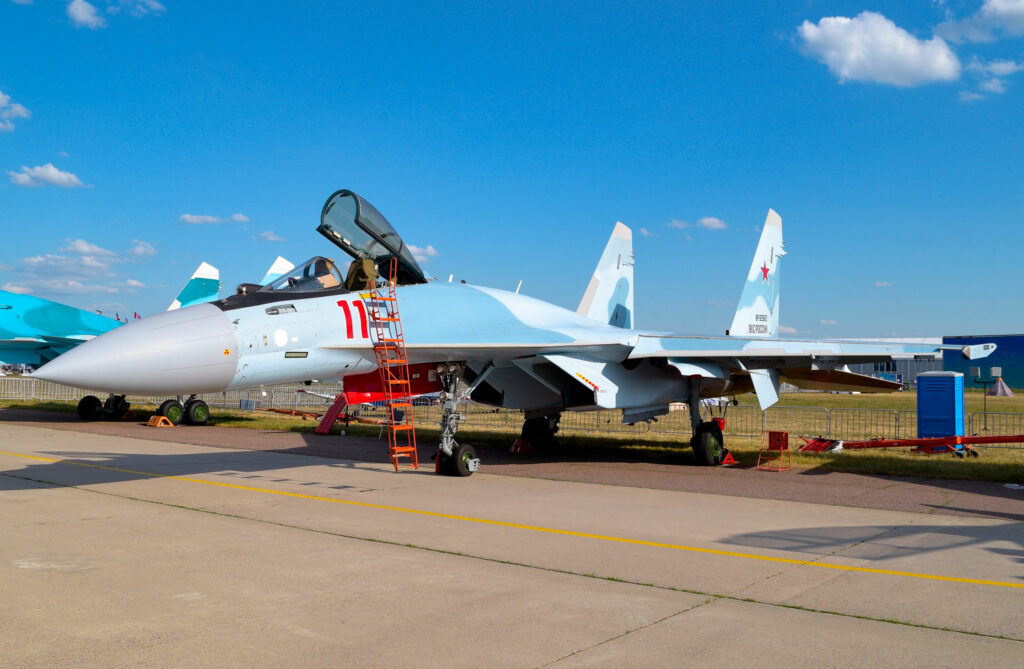
Algeria is adding Russian Su-35 fighters to its air fleet, thus strengthening its military power and influencing the regional balance.
Algeria recently added Russian Su-35 Flanker-M multirole fighters to its air force. These aircraft, initially intended for Egypt, had not been delivered due to diplomatic pressure. The transfer to Algeria marks a significant development in the country’s military strategy, strengthening its air capabilities and influencing the balance of power in North Africa. This acquisition comes at a time of heightened geopolitical tensions and a reorientation of military alliances.

Acquisition of the Su-35: context and implications
In March 2025, satellite images confirmed the presence of Su-35 Flanker-M fighters at the Oum El Bouaghi airbase in eastern Algeria. These aircraft, recognizable by their specific camouflage, were part of a batch initially built for Egypt between 2020 and 2022. The Egyptian contract had been suspended due to diplomatic pressure, particularly from the United States.
The Su-35 is a 4++ generation multirole fighter, equipped with an active electronically scanned array (AESA) radar, vector thrust and advanced avionics. Its integration into the Algerian fleet represents a significant technological advance. Although the exact number of aircraft delivered has not been confirmed, sources indicate that at least four Su-35s bear the insignia of the Algerian Air Force. This acquisition strengthens Algeria’s position as the main African customer of the Russian aeronautics industry.
Modernization of the Algerian Air Force
The Algerian air force has a diverse fleet, including 63 Su-30MKA, 40 MiG-29S/M/M2, 42 Su-24MK2 and 16 Yak-130. The addition of the more modern Su-35 improves the country’s defense and intervention capabilities. In addition, Algeria has expressed interest in the Su-57, a fifth-generation stealth fighter, although deliveries are delayed due to production constraints in Russia.
This modernization is part of a strategy to maintain regional air superiority. Algeria is also investing in advanced air defense systems, thus strengthening its defensive posture.
Regional geopolitical consequences
Algeria’s acquisition of Su-35s has repercussions on the balance of power in North Africa. It could encourage neighboring countries to strengthen their own military capabilities. For example, Morocco recently acquired Turkish Bayraktar TB2 drones and is considering purchasing Western fighter planes.
This arms build-up could intensify the arms race in the region, increasing tensions and the risk of conflict. It also highlights the importance for countries in the region to diversify their strategic partnerships and strengthen their autonomy in defense matters.

Impact on Russian-Iranian relations
Initially, the Su-35s were intended for Iran, which was seeking to modernize its aging air fleet. However, diplomatic and logistical obstacles have delayed this acquisition. The transfer of the aircraft to Algeria could be perceived by Iran as a setback, despite the close ties between Moscow and Tehran.
This situation illustrates the challenges Russia faces in honoring its commitments to its partners, particularly in a context of international sanctions and geopolitical pressures. It also highlights the complexity of alliances and divergent interests in the region.
Outlook for the Russian aviation industry
The Russian aviation industry, facing sanctions and increased competition, seeks to maintain its presence in the international market. The export of Su-35s to Algeria represents an opportunity to strengthen its position in Africa and to compensate for the loss of certain traditional markets.
However, Russia must overcome significant challenges, particularly in terms of production, maintenance and logistical support. The ability to provide modern and reliable aircraft will be decisive for the future of its aeronautics industry.
War Wings Daily is an independant magazine.